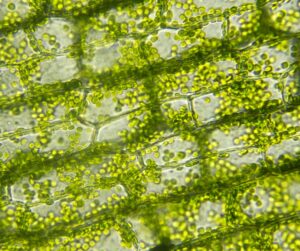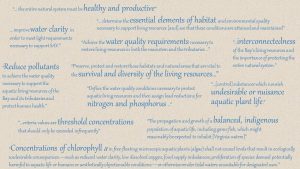Chlorophyll a Criteria
Interstate Commission on the Potomac River Basin
How much is too much?
Chlorophyll is the green pigment found in the cells of algae and plants. It is common to use chlorophyll a as an indicator of phytoplankton biomass in surface waters.
The partners of the Chesapeake Bay Program established narrative chlorophyll criteria for the entire Chesapeake Bay in 2003. Virginia and the District of Columbia took the additional step of establishing numeric criteria for specific tidal waters.
In 2011, Virginia Department of Environmental Quality (VADEQ) initiated a review of the scientific basis of their numeric chlorophyll a criteria applied to James River tidal waters.
C. Buchanan (ICPRB) was a member of the study’s Scientific Advisory Panel. One of her contributions was a report summarizing some of the longer-term data analyses and findings for phytoplankton and chlorophyll that have relevance to Chesapeake Bay as a whole, including the tidal James River.
Click here for the Report: From Programmatic Goals to Criteria for Chlorophyll a (ICPRB Report 16-1)
The report derives, in a logical progression, numeric chlorophyll a thresholds that are protective of Chesapeake Bay’s designated uses. The progression begins with programmatic goals expressed in Chesapeake Bay Program agreements and state water quality standards, and builds on narrative standards, principal ecological concepts, and empirical evidence.
Reference Criteria
 Crucial to the application of any criteria is a reference for measuring criteria attainment. A simple, symmetrical 10% hyperbolic curve was at the time of this project the default reference for Virginia’s James River chlorophyll a criteria. The curve is intended to represent the spatial and temporal exceedances of the criteria in healthy phytoplankton populations. Criteria approximating the upper percentiles (90th – 95th) of chlorophyll a concentrations in high quality waters produced biological reference curves that tracked the default 10% hyperbolic curve.
Crucial to the application of any criteria is a reference for measuring criteria attainment. A simple, symmetrical 10% hyperbolic curve was at the time of this project the default reference for Virginia’s James River chlorophyll a criteria. The curve is intended to represent the spatial and temporal exceedances of the criteria in healthy phytoplankton populations. Criteria approximating the upper percentiles (90th – 95th) of chlorophyll a concentrations in high quality waters produced biological reference curves that tracked the default 10% hyperbolic curve.
Overall, James River criteria are generally protective of high-quality environmental conditions in Chesapeake Bay open water designated uses. When Virginia’s current 3-year assessment procedures are applied to the Chesapeake data set of high-quality tidal waters, small but avoidable statistical biases and artifacts inherent to the method can be seen.
Biological Reference Curves for Assessing the James River Chlorophyll a Criteria (ICPRB Report 14-3)
Return to Aquatic Life Main Page


